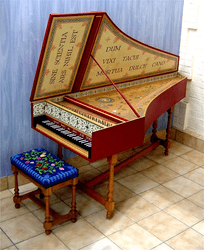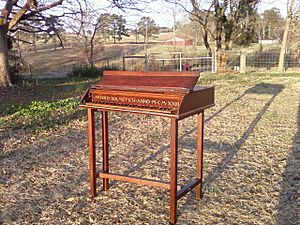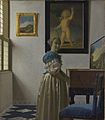Harpsichord facts for kids

Harpsichord in the Flemish style
|
|
| Classification | Keyboard instrument |
|---|---|
| Related instruments | |
| Spinet | |
Harpsichords are keyboard instruments that make sound by plucking strings. Imagine a keyboard attached to a psaltery, which is an ancient string instrument. This is how harpsichords are thought to have started.
They are different from a clavichord, where the strings are hit. A piano is actually more like a clavichord than a harpsichord.
On a piano, you can play louder or quieter by pressing the keys harder or softer. But on a harpsichord, the volume stays mostly the same. However, some larger harpsichords have special "stops." These stops can change the sound in different ways. The biggest harpsichords even have two keyboards, called "manuals." This allows for more sound options. For example, you could play the main tune on one manual. Then, you could play a quieter accompaniment on the other.
Some smaller harpsichords were called "virginals." Maybe this was because young girls often played them. There are also spinets. These were very small and sometimes shaped like a bird's wing. You could even pick them up and place them on a table.
Harpsichords were super important in music from the Renaissance and Baroque periods. They were used as solo instruments. They also played along with an orchestra. Some famous composers who wrote music for the harpsichord include William Byrd (1543-1623), François Couperin (1668-1733), Domenico Scarlatti (1685-1757), and Johann Sebastian Bach (1685-1750).
Contents
Types of Harpsichords
The Main Harpsichord
When people say "harpsichord" today, they often mean the larger type. This instrument looks a bit like a grand piano. It has a roughly triangular shape. The long strings for low notes are on the left. The short strings for high notes are on the right. Its shape is usually longer and more curved than a modern piano.
Virginals
A virginal is a smaller, simpler type of harpsichord. It is usually rectangular. It has only one string for each note. The strings run parallel to the keyboard. The keyboard is on the long side of the instrument's case.
Spinet
A spinet is a harpsichord where the strings are set at an angle. This angle is usually about 30 degrees to the keyboard. The strings are too close together for the plucking parts (called jacks) to fit between them. So, the strings are arranged in pairs. The jacks fit in the larger spaces between these pairs. Each jack plucks a string next to its space.
The English writer Samuel Pepys often mentioned his "tryangle." This was not the musical percussion instrument we know today. Instead, it was a name for small, triangular spinets. These spinets played notes an octave higher than usual.
Clavicytherium
A clavicytherium is a harpsichord that stands upright. Its soundboard and strings face the player vertically. This design saves space, just like an upright piano. In a clavicytherium, the jacks move sideways. This means their actions are more complex than other harpsichords. This is because they don't use gravity to help them move.

Ottavino
Ottavini are small spinets or virginals. They play notes an octave higher than standard harpsichords. These smaller instruments were very popular in the early Renaissance. While their popularity lessened later, the ottavino remained a favorite home instrument in Italy. This was true even until the 19th century.
In some places, an ottavino was often paired with a larger virginal. It would fit into a small space under the larger instrument's soundboard. The ottavino could then be taken out and placed on top of the virginal. This created an instrument that worked like it had two keyboards. These are sometimes called 'mother-and-child' or 'double' virginals.
Images for kids
-
The soundboard of a harpsichord showing Chladni patterns. These patterns show how sound vibrations affect the surface.
-
A false inner–outer harpsichord from the Deutsches Museum in Munich.
-
Jan Vermeer's famous painting Lady Standing at a Virginal shows how the instrument was often placed on a table and played while standing.
See also
 In Spanish: Clavecín para niños
In Spanish: Clavecín para niños










